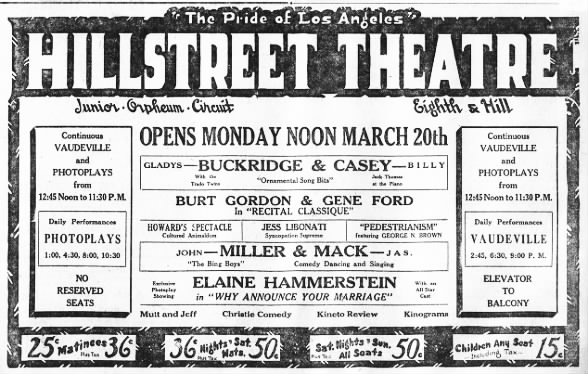
RKO Hillstreet Theatre
801 S. Hill Street,
Los Angeles,
CA
90014
801 S. Hill Street,
Los Angeles,
CA
90014
![]() 14 people
favorited this theater
14 people
favorited this theater
Showing 1 - 25 of 63 comments
Grand opening ad: Hillstreet theatre opening Sun, Mar 19, 1922 – 59 · The Los Angeles Times (Los Angeles, California) · Newspapers.com
Hillstreet theatre opening Sun, Mar 19, 1922 – 59 · The Los Angeles Times (Los Angeles, California) · Newspapers.com
Clearer copy of the 1953 photo added.
The USC photo links from above, plus a few “new” ones, are now here:
View link
View link
View link
View link
View link
View link
View link
View link
View link
Here is part of an article in the LA Times on 4/29/63:
The largest theater in downtown Los Angeles closed two weeks ago-at least temporarily-with no more fanfare than was accorded its opening 41 years ago. The Hillstreet, at 8th and Hill, opened Monday afternoon March 20, 1922, with a vaudeville program and the film “Why Announce Your Marriage?†with Elaine Hammerstein. The theater closed Sunday evening April 14, 1963 with Vincent Price in “Diary of a Madmanâ€.
Although “shortage of product†was the reason given for the theater’s closing, it is reliably estimated that at each of the last three evening performances the 2,752 seats were occupied by a tiny fraction of its capacity. Metropolitan Theater Corp., which leased the Hillstreet from the Radio-Keith-Orpheum Corp. in 1959, said it hopes to resume regular programming when summer vacation begins for the city’s schoolchildren.
Designed by G. Albert Lansburgh, the most prolific theater architect in western United States, now living in retirement in San Mateo, the Hillstreet has an almost identical “sister†theater, the Golden Gate, in San Francisco. Though somewhat smaller than the San Francisco house, the Hillstreet has the same faintly ecclesiastical Spanish Renaissance styling. The fan-vaulted ceiling in the foyer of the Hillstreet was covered up when the entrances to both theaters were modernized on their 25th anniversaries.
It looks like they are turning the old bank building on the theater space into a nightclub. Here is a 1940 ad from the LA Times:
http://tinyurl.com/lon8j6
Here is a 1938 ad from the LA Times:
http://tinyurl.com/qw39a8
Here is a late 1930s view from the USC archive:
http://tinyurl.com/cm6klq
The April 26, 1947, issue of Boxoffice Magazine ran an article about the recent remodeling of the Hillstreet Theatre, with several photographs. The remodeling was designed by the A.B. Heinsbergen Company.
Here is a September 1938 ad from the LA Times:
http://tinyurl.com/6rdkwl
Aiming right at the competition, a circa 1931 ad for the RKO Hillstreet can be seen on Hollywood Boulevard. The photo is from the USC archive.
http://tinyurl.com/4xpm8a
Maybe I should make a graphic novel called The Life & Loves of the Trado Twins….hmmm.
Look at page seven of this Canadian newspaper from 1922. The twins and Jack Thomas are bottom billed:
http://tinyurl.com/3vr4go
Here’s something from the day before this theater opened:
(March 19, 1922 LA Times)
JUNIOR HOUSE TO OPEN.
Tomorrow afternoon the new Hillstreet Theater of the Junior Orpheum Circuit at Eighth and Hill will open its doors to the public without any formal ceremonies. The new theater is a model of the most advanced ideas in theater construction, and embodies many new features for the comfort and pleasure of the patrons. Continuous vaudeville and exclusive photoplay showings will comprise the entertainment offered, with excellent musical programs rendered by a large orchestra, with Allen Hall directing and Charles Hayes O'Haver presiding at the mammoth three-manual Moller organ. The opening bill gives an excellent idea of the class of the attractions to be offered at the Hillstreet Theater and is sure to appeal to every taste. Gladys Buckridge and Billy Casey, the Ziegfeld stars, with one of the season’s most elaborate productions entitled “Ornamental Song Hits,” hold the headline position. They will be assisted by the clever Trado Twins, dancers, and Jack Thomas at the piano.
{I wish I had a photo of those Trado Twins….}
Here is a January 1930 ad from the LA Times:
http://tinyurl.com/3vyvsb
Its such a damn shame that they chose to tear down this theater/office building after a mere 40 years!! Yet, the Warner Bros. Downtown theater/office building at 7th & Hill and the Loew’s State theater/office building at 7th & Broadway are still around after more than 80 years…
That’s funny…because of the sepia color from the scanning I thought they were from an old out of print book. I already own the new IA book…it’s great.
That’s the last of them. Check the images of america section at Barnes & Noble and look for LA theaters.
Ken, the photos look as though they are from a book and I’d like to find a copy. Will you tell the title?
ken, where are you getting these photos?
Demolition awaits in 1965:
http://tinyurl.com/33efdv
Here is a 1930 ad:
http://tinyurl.com/3b5q8g
Wallace Reid was a very popular silent film star who died shortly after the advent of talking pictures. It looks like his wife directed the Warner Baxter film.
Here is a June 1929 ad:
http://tinyurl.com/35cggl
Here is a 1954 ad from the LA Times:
http://tinyurl.com/2vntdf
The Junior Orpheum Circuit ran combination houses which featured moderately-priced shows consisting of a movie and several acts of vaudeville, presented either continuously or (usually) three times a day. Regular Orpheum Circuit theatres were two-show-a-day, all-vaudeville houses, though of course many of them soon converted to combination houses or ran only movies as vaudeville withered away.